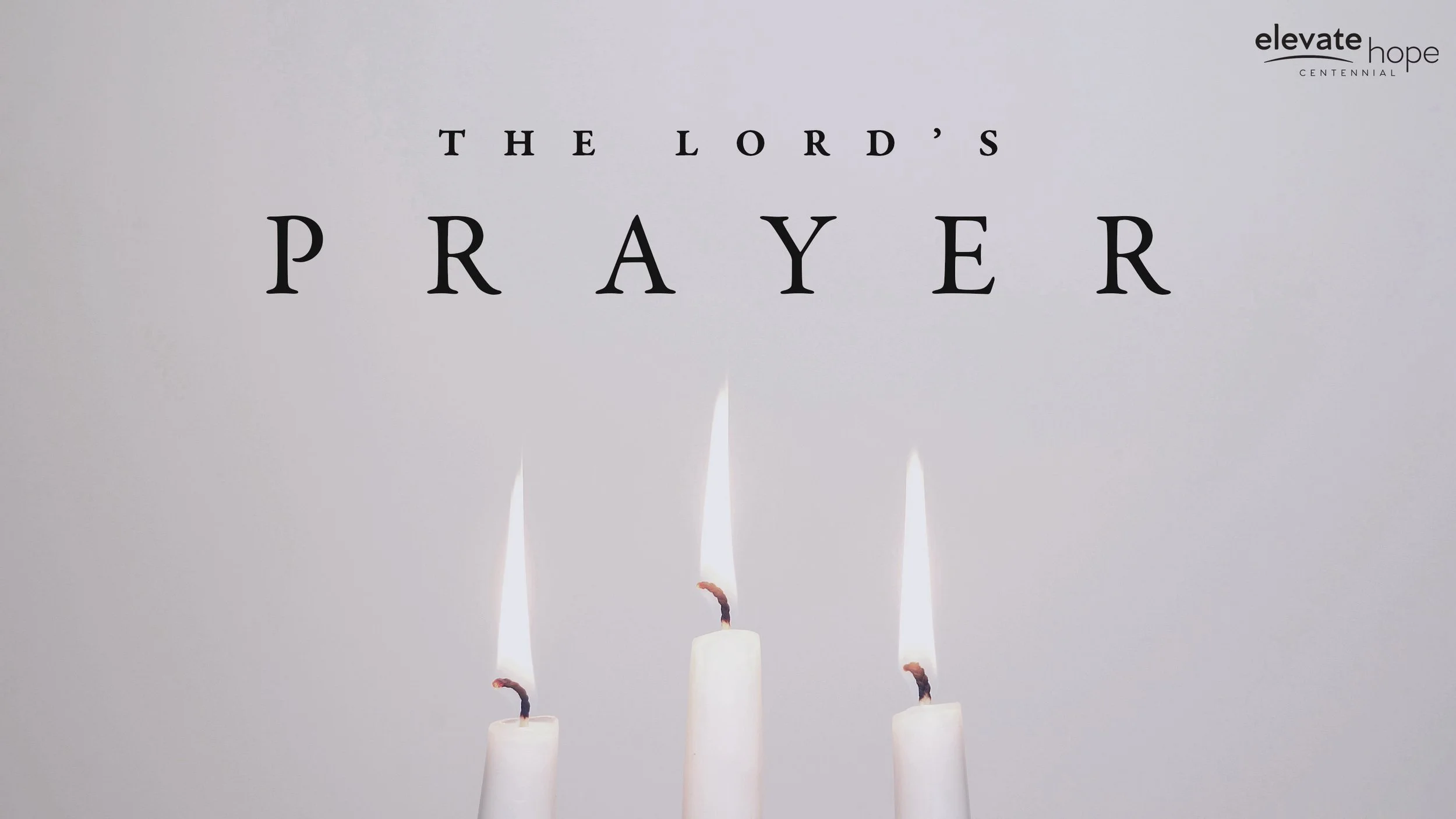Sermon Series
- Becoming the Gospel - 1 and 2 Thessalonians
- Building A Summer Body
- Building Healthier Relationships
- Disconnected
- Follow the Star
- God's Story
- Joy To The Troubled World
- Left Right or Light?
- Missing Home
- Our Motto and Mission
- Prayer
- Psalms: Language For Life The Way It Is
- Renewed
- Romans: The Power of the Gospel
- Ruth: The Advent of A Redeemer
- Seen
- Stuck Inside
- The Advent of Christ
- The Book of Acts: Live Boldly
- The Book of Daniel
- The Book of Ephesians
- The Book of James
- The Book of Jonah: Running Away From God
- The Book of Judges
- The Book of Malachi
- The Book of Matthew
- The Gospel of Mark: Seeing Jesus
- The Holy Spirit
- The Life You've Always Wanted
- The Miracles of Christmas
- The Secret To Healthy Relationships
- The Sin of Racism
- The Spiritual Life
- The Ten Commandments
- Thrive: A Summer Series
- Twenty Twenty What?
- We Need Christmas
- Who Am I?
- Why Pray?
The Advent of Christ: Hope in Christ - John 1:1-18
This Sunday marks the first day of Advent. During the Advent season the Church enters a season of waiting. Waiting is profoundly countercultural; we don’t have to use our waiting muscles much anymore. Black Friday starts in October and Christmas starts before Thanksgiving; for $2 more our packages can arrive at 4:00am the next day. The first Advent was a time marked not by celebration and twinkling lights but by darkness and longing for Christ’s arrival and redemption. Before Jesus came in that manger, long lay the world in sin and error pining. The thrill of hope was in the air, but a weary world was not at the rejoicing part yet. It’s hard to remember what waiting was like for something you already have. We already have what Jesus came to offer; we no longer have to wait in darkness. But Advent still disciples into us the ability to wait and to long for the completion of what we have in Jesus as we wait for His return. Longing is not the same as waiting a mere 12 months; longing is waiting a lifetime, waiting until we are weary. Longing carries with it the temptation to give up hope in a way that simple waiting does not. What are you longing for? In the weeks of Advent to come, we will look at the four traditional themes celebrated by the Church around the world for over a thousand years: Hope, Peace, Joy, and Love. Let’s look at our first Advent text together this morning and see where the hope of Christmas lies in John 1.
The Lord’s Prayer - Matthew 6:9-15
Join us this Sunday as we read The Lord’s Prayer in Matthew’s gospel and learn how this prayer gives us a name, honor, a mission, provision, a likeness and protection (ft. Colin Campbell, Member at Elevate Hope Centennial).
The Gospel of Mark: Seeing Jesus - Mark 15:39-16:8
Some events are just history; they happened with little or no impact on the world today. Other events in history still bear lasting change today. The resurrection of Jesus is a historical event; it happened. Government officials, soldiers, rich and poor, ordinary people—secular and religious alike—had to wrestle with an empty tomb. It’s easy to forget the impact that the resurrection has had on our lives every moment of today. Mark's gospel ends in such a way that we need to ask ourselves along with the women at the tomb, ”What does it all mean?” Join us this morning as we bring our series in the Gospel of Mark to a close!
The Gospel of Mark: Seeing Jesus - Mark 15:20-39
Mark’s gospel opens with: “The beginning of the gospel of Jesus Christ, the Son of God.” Writing from within the city of Rome, Mark’s entire gospel is an attempt to show the Romans that Jesus Christ truly was the Son of God; all of Mark’s gospel moves towards that aim. Now after the death of Christ, after He has poured out His life on the cross, the first Roman—a hardened soldier at the foot of the cross—finally understands who Jesus really is. The cross of Christ has had its effect. What started with one Roman soldier at the foot of the cross had grown to well over 1000 Christians in Rome by the time Mark wrote his gospel. What was it that made this first Roman soldier see what Mark hopes that we all will see, that Jesus is the Son of God given for us?
The Gospel of Mark: Seeing Jesus - Mark 15:1-20
We like stories of hidden royalty and mistaken identity. There is something we continue to love about a king or a princess, who has been mistreated and misunderstood their entire life, revealing in the final scenes that they are in fact the ruler of the kingdom. In Charles Dickens’ classic, The Prince and the Pauper, Tom Canty gets mistaken for a prince and Edward Tudor gets mistaken for a lowly beggar simply because of their outward appearance. So it is with the Caesars, the kings and with Jesus in the final week of His life on earth. Those with the titles and thrones may look like Caesars and kings because of their palaces and power, but the one who is getting beaten, spit upon and treated like a criminal, though He doesn’t look at all the part, is king and lord over all, even over the ones who are sending Him to His death. The triumphant reveal of Jesus’ identity will come in part with the empty tomb and the risen Jesus. But even now our king is a king who is ruling in this world but still hidden. His kingdom is a kingdom that has already come but not yet in full as it will. But on the day Jesus stood in Pilate’s chambers in Jerusalem, the only thing anyone could see was a man claiming to be king who looked nothing like the part. So they dressed Him up and hailed Him as king only in mockery. But unlike our favorite stories, Jesus’ mistaken identity was no accident. The king who hung the stars in their place does everything He can to willingly allow Himself to be taken for a criminal and hung on a cross for us.
The Gospel of Mark: Seeing Jesus - Mark 14:43-72
At the end of Mark 14, two disciples are placed side-by-side: Peter and Judas. Two men who sinned greatly against Jesus in His time of need, but two men with two very different fates. In their story is the incredible offer of our own salvation and God’s offer of salvation to our world. In our text this morning we see our denial, betrayal, and abandonment of God, as well as the life saving, life changing, restoring grace of God as it is truly offered to us in the gospel. Join us as we look at the end of Mark 14 this morning.
The Gospel of Mark: Seeing Jesus - Mark 14:26-42
As we come to Mark 14, we recognize that each of the gospel writers slows down to focus on Jesus’ last week, but especially His last day before His death. The core truth of our passage this morning is that Jesus was denied, abandoned and forsaken so that we would be accepted, loved and redeemed. Join us in Mark 14 as we examine Peter’s sin, Christ’s sorrow and our salvation. (ft. Tim Sin, Assistant Pastor at Denver Presbyterian Church).
The Gospel of Mark: Seeing Jesus - Mark 14:1-25
As we go through Mark together, we come to the final week of the life of Jesus. The week that the crowds tried to get Him to avoid; the week His disciples tried to get Him to avoid. Even Satan himself at the start of Jesus’ ministry tried to get Him to avoid this week. This is the week that the chief priests and scribes thought would never come. For every gospel writer, this week occupies the majority of their gospel. The early church knew that this wasn’t just another list of historical events; this was the week in history that changed everything. This week would form the basis of the church’s worship and of her witness to the world. The worshipping church worships a risen Savior; the witnessing church proclaims a crucified and risen Savior. And the week begins with a beautiful act of worship by one of Jesus’ followers that would be remembered and recounted until this very day. Let’s look together in Mark 14.
Psalms: Book IV - Psalm 91
As we go through the gospel of Mark together, we are coming to the events leading up to Jesus’ trial and passion. In preparation of that, let’s examine a psalm that will help us in understand the suffering of Jesus. This morning we will be examining Psalm 91.
The Heart of Discontent - Exodus 20:17
Join us this Sunday as we once again dive into Exodus 20 to look at the tenth and final commandment — You shall not covet. (ft. Colin Campbell, Member at Elevate Hope Centennial).
The Gospel of Mark: Seeing Jesus - Mark 13
In Mark 13, Jesus’ disciples wanted to know if there would be any signs that the end times were coming. How will we know when the end is here? What should we be watching for? Jesus doesn’t tell them exactly when but He does tell us exactly what. He tells them exactly what they should be doing while they watch and wait for the signs. And this whole discussion starts because Jesus’ followers are in awe of the beauty of their place of worship, the temple.
The Gospel of Mark: Seeing Jesus - Mark 12:38-44
In 2006, the cost of producing a penny became higher than its actual face value for the first time. Driven by the increasing price of metals like zinc and copper by 2024, the cost to produce and distribute one U.S. penny reached an all time high of 3.69 cents, over three times its actual value. In our passage this morning, Jesus calls over His disciples to observe something that gives joy to the heart of God: a poor widow gives to God what Jesus says are her last and only two pennies. He says that the value of those two pennies given with the heart that she has is greater than the value of the large amounts given by the wealthy worshippers that day who had plenty to spare. Jesus knew what is true of the penny today. In God’s economy what it takes to form and to forge a heart that is willing to give those last two pennies is of more value than the face value of the actual pennies themselves. God’s economy is famous for not working the same way that our earthly economy does. Let’s look deeper at how two pennies in an open hand to God are a much greater sum than a closed fistful of dollars.
The Gospel of Mark: Seeing Jesus - Mark 12:28-37
On December 2, 2018 about 90 people shuffled into the downstairs gym of Deer Creek Church in Littleton, Colorado. Many of them were there out of curiosity, some were there for the free bagels. But most were there because they wanted to be a part of a new work of the gospel in Metro Denver in some way. Out of that gym, and from this surrounding community, came a group of about 35 adults, toddlers, children and teens who formed the Launch Team of Elevate Hope Centennial: a church for people who aren’t perfect and don’t pretend to be, bringing the real and lasting hope of Jesus to Metro Denver and beyond. We didn’t know what was going to happen, but we knew that God’s plan for reaching cities with the hope of the gospel is to plant more churches. And we would hear His call to start a new church in Centennial, Colorado where people could Connect with God, Connect with Others and Connect Others to God who were far from Him. In the last part of our Scripture passage this morning, people wanted to debate where the long awaited Savior would come from but Jesus wanted them all to know what kind of Savior would he be. And as I was prayer walking around this building a couple of weeks ago, I believe that our going to Dry Creek elementary was not about the “where are we going to be a church this summer?” but “what kind of church are we going to be when we return?” What does it look like to live out Jesus—to embody Him—in our communities so that His glory expands to every corner of South Metro Denver. That is what being a disciple of Jesus is all about!
The Gospel of Mark: Seeing Jesus - Mark 12:18-27
God’s ultimate plan for human life is resurrection. Resurrection into new life, into a new existence that has the capacity to dwell with the holy God who made us for eternity. If the ultimate plan of God for His people is resurrection, then our sin-wrought death is no longer the period at the end of our life story. How would we summarize that great story in all of its hope and glory? Jesus chooses one unlikely verse of Scripture to do just that when confronted with skeptics who denied that God can raise us to something new. Let’s look at our passage this morning in Mark 12.
The Gospel of Mark: Seeing Jesus - Mark 11:27-12:17
Mark 11:27-12:17 is all about the issue of authority. Last week we read that Jesus came into the temple, furious that the outer court which was made to be used by all nations seeking to worship God was taken up by God’s own people going about the busy-ness of their own worship and activity. Jesus turned over their tables, drove out the merchants and money changers, and wouldn’t let anyone pass through who wasn’t there to worship. You can imagine how jarring that was for everyone in the temple, so it was probably just as jarring when Jesus strolls back into the temple the next day. As He does so, the highest authorities in the Jewish temple, the chief priests, scribes and elders, confront Jesus about His authority to be doing these things. They set out to trap Jesus in His words that they might be rid of Him, but Jesus responds with questions and parables of His own, avoiding their snares while setting the trap for them.
The Gospel of Mark: Seeing Jesus - Mark 11:1-25
The temple was a marvelous structure, but for Jesus it was something more; it was His Father’s house which was meant to reflect His Father’s heart. And what was His Father’s heart for the temple? To draw people from all nations to Himself. It was the one place they could offer sacrifice for the forgiveness of their sin, the one place they could meet with God, come to know Him and to corporately call on His name in prayer. The temple was not just a building; it was the place where heaven met earth, where all people could come and know the God of Israel. So on the way to His Father’s house, Jesus sees a fig tree that has such an explosion of green leaves that its beauty can be seen from a great distance. But upon closer examination of what is beneath the leaves, the tree is completely fruitless. But we aren’t troubled by the fact that the tree is unfruitful because the text tells us that it wasn’t the season for figs. What is troubling is that Jesus knows that the tree should not be expected to have any fruit on it and yet He judges the tree and it withers under His judgement of its fruitlessness. Let us examine how Jesus is making the tree itself a living parable about the state He finds God’s people in at His Father’s house.






